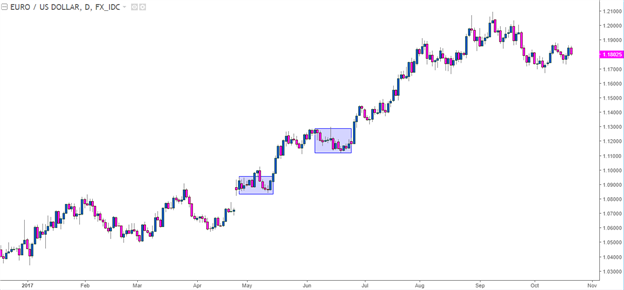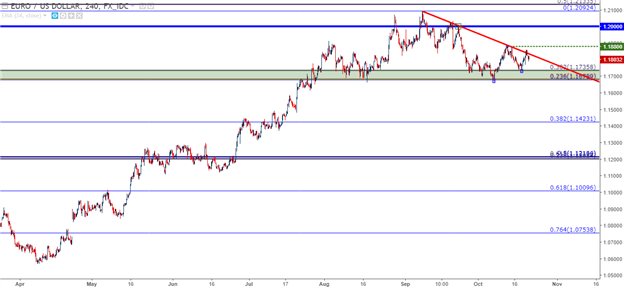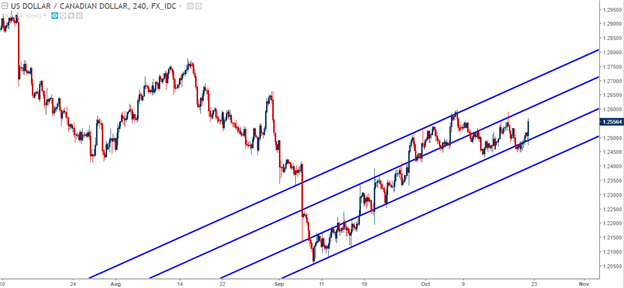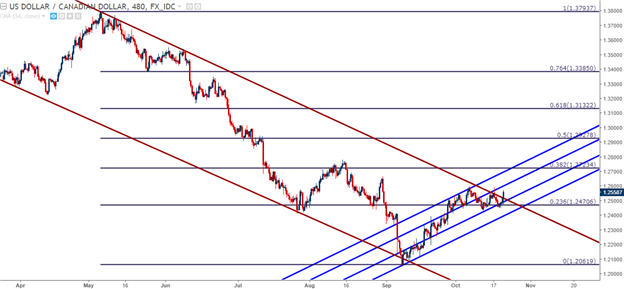Talking Points:
- Two of the cleaner 2017 trends come into question next week as Central Bank rate decisions out of Europe and Canada are released into markets.
- While the Bank of Canada has been active of recent, the ECB has been apparently trying to avoid activity. But their time appears to be running out. Will we finally hear the ECB’s next steps with stimulus at next Thursday’s meeting?
- Want to see how Euro and USD are holding up to the DailyFX Forecasts? Click here for full access.
To receive James Stanley’s Analysis directly via email, please sign up here
Next week brings the highly-awaited rate decision from the European Central Bank in which markets may finally hear what the ECB plans to do with their stimulus program beyond the current December expiration. This has been a brewing theme for much of the year: At the ECB meeting in April, just after the first round of French elections resolved in a rather market-friendly manner, ECB President Mario Draghi was directly asked what the bank might do with QE when the program was set to expire in December, almost 8 months away. At the time, growth and inflation had begun to show with a bit more consistency, leading to the idea that the massive amounts of liquidity pumped into the European financial system were finally ‘working’ to drive inflation-higher.
Mr. Draghi replied that the ECB hadn’t even discussed the prospect of stimulus exit. And a Euro that had been bid-higher on the prospect of an earlier stimulus exit retreated back to support, and stayed there for about two weeks before bulls came back-in. At the June ECB rate decision – the same thing; Mario Draghi was asked whether the ECB had discussed stimulus exit and when he replied that they hadn’t, EUR/USD moved back down to support, worked around that level for a couple of weeks before bulls finally re-grabbed control.
EUR/USD Daily: April, June ECB Sees Draghi’s Deferrals Soften the Euro for ~2 Weeks

Chart prepared by James Stanley
This happened again in July, but the market response was far different. Rather than pushing EUR/USD back-down to support as we’d seen at the previous two ECB meetings; bulls drove prices higher, running the pair up to fresh annual highs. But – that move did not stop there. That strength continued through much of August, and at the Jackson Hole Economic Symposium later in the month, another drive availed itself.
EUR/USD Daily: July ECB Brings Far Different Result as Bulls Directly Fade Draghi’s Dovishness

Chart prepared by James Stanley
This time, Mario Draghi didn’t even have to touch the topic of monetary policy. At that speech in Wyoming, Mr. Draghi talked about the benefits of open borders and immigration. It appeared as though he was tactically trying to avoid anything that could be construed as forward-looking around policy metrics. But, nonetheless, Euro bulls ran the currency-higher under the presumption that this avoidance of the topic was construed bullishly for the single currency.
EUR/USD Daily: At Jackson Hole (in Green), Draghi Avoids Policy and Bulls Drive > 1.2000

Chart prepared by James Stanley
At the September ECB meeting, there was a large expectation that we’d get some type of announcement around what the bank was going to do with the stimulus program that was set to expire in December. We didn’t get that announcement, and Mario Draghi, again, took a rather dovish tone to markets that were expecting a hawkish tilt. This didn’t necessarily deter Euro bulls, as the day after that meeting saw EUR/USD set another fresh high. But in the weeks since, prices have lagged as that 2017 bullish up-trend put in a 23.6% retracement; finding support in a huge zone of longer-term interest that runs from 1.1685-1.1736. It appears as though the 1.2000 psychological level has been a bit too aggressive for Euro bulls, at least just yet, as life above 1.2000 has been far different than life below.
EUR/USD Four-Hour: Unable to Hold Above 1.2000, Longer-Term Support holds 1.1685-1.1736

Chart prepared by James Stanley
There is but one meeting before that December rate decision. December is when the current ECB QE program is set to expire, and the bank is running out of time to offer adequate details to market participants as to what they want to do or how they want to do it once the current program finishes a short two months away.
The hope for a full-scale stimulus exit appears to be off-the-table at this point; in later September we heard from the ECB’s Chief Economist who, instead, suggested that the bank might look to ‘recalibrate’ the current program while implying an extension in duration. The prevailing thought is that we’re going to see a reduction, and extension of the current program. The big question is by how much and for how long? Many expectations appear to be building around the 30 Billion a month figure, but at this point, that’s just an educated guess.
The longer-term chart of EUR/USD remains constructive for bullish themes, as prices remain supported at the big zone of longer-term support that runs from 1.1685-1.1736. A bullish continuation move carries a key target at the psychological level of 1.2000, and a top-side break of that level exposes potential resistance, or topside targets at 1.2134 and 1.2250.
BoC Next Week
Next week also brings a BoC rate decision. We probably won’t get any moves here, as the bank hiked in July and then again, unexpectedly, in September. At this stage the BoC will likely want to allow for a bit more time for those hikes to continue to transmit through the Canadian economy before making any additional modifications to policy; but the tone with which the bank is looking at future rate hikes will likely drive USD/CAD price action.
This morning’s Canadian inflation print came-out a bit softer than expected at 1.6% versus the expectation of 1.7%. But – this is still higher than last month’s 1.4%, and this may not be much of a hindrance to the BoC’s hawkish stance. The big question for USD/CAD is when the bigger picture down-trend might be ready to resume…
As we saw the Bank of Canada shifting to a more-hawkish position earlier in the year, a really weak U.S. Dollar provided the backdrop for a rather aggressive down-trend to show in the pair. USD/CAD fell from a May high just below 1.3800 to a September low just above the 1.2000-figure as this divergence got priced into the pair.
USD/CAD Daily: 1,700+ Pip Drop in Four-Month Span, May-September

Chart prepared by James Stanley
This drop included breaks of numerous support levels. There was little that could stand in the way of the freight train that was USD/CAD in the four month span from May to September. But it was after that last rate hike in September that something appeared to begin shifting, as buyers began to show and prices started to move-higher. This created a bear flag formation on the Daily chart, as we look at below:
USD/CAD Four-Hour: Bear Flag Develops Shortly After September Rate Hike

Chart prepared by James Stanley
While the bullish move that’s driven that channel higher in the above chart has been rather clean and consistent, it’s still corrective on a longer-term basis. We’ve yet to retrace 38.2% of the prior bearish trend, and we’ve seen continued support around the 23.6% retracement, indicating that bulls aren't yet done in USD/CAD.
USD/CAD Eight-Hour: Continued Support at 23.6% Retracement Highlights Bullish Potential

Chart prepared by James Stanley
The big question for next week around the BoC is just how aggressive they want to be with rate hikes moving forward. We’ve recently seen the BoC pull back a little bit on that hawkish rhetoric, but is this something that will continue?
Given the fact that buyers have continued to offer support around that 23.6% retracement throughout October, it would appear that a move-higher may be in the cards. It would be opportune for the BoC to remain less-hawkish while the Fed ramps up rhetoric towards a December rate hike that could equalize price action in the pair, and this could spell a move as deep as 1.2900 while the longer-term, bearish nature of the setup remains intact. Topside targets in USD/CAD can look towards 1.2660, and 1.2723 as potential points of next-stop resistance.

Chart prepared by James Stanley
--- Written by James Stanley, Strategist for DailyFX.com
To receive James Stanley’s analysis directly via email, please SIGN UP HERE
Contact and follow James on Twitter: @JStanleyFX






